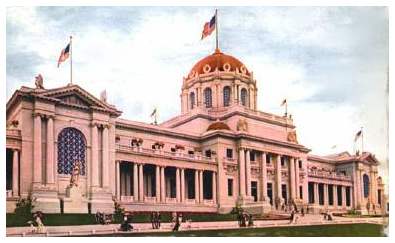Missouri, the home state entry was situated on Government Hill. A towering magnificent piece of Roman Architecture; fitting as the host pavilion, it was the largest structure on the Plateau of States.
Her palatial pavilion, 366x160 feet, was erected at a cost of 105,480 dollars, and was of Roman style of architecture. A great golden dome rose from the center of the massive building, and was crowned by an exquisite sculptured figure, also gilded, typifying "The Spirit of Missouri," which was modelled by a young St. Louis woman, Miss Carrie Wood. The glint of this dome can be seen from afar, and, like the guiding sun, directed the stranger to the broad steps rising to the colonnaded entrance. Ionic columns enclosed a gallery extending around the building, interrupted only by projecting wings of the edifice. Each wing had a huge art window facing the avenue on which the pavilion fronts, and was finished at the top by a pointed gable with a highly ornamental cornice. The frieze above the columns is undecorated, and the dome itself was unembellished except for the balustrade surrounding the gallery which encircled the large hemisphere, and which being 130 feet from the ground afforded an excellent view of the Exposition picture.
Many sculptured figures were seen on and about the building, among them being four colossal groups representing Peace, Music, Art and Architecture; two Missouri bears, of plaster, were on either side of the south and north entrance, and ornamental urns finished the top of the upper balcony which followed the course of the first floor galleries.
Across the front of the building and on the entablature over the columns was the gold-lettered inscription:
"Embracing within her confines all the elements of an empire, devoted to all the arts and sciences that advance civilization, Missouri, the central State of Louisiana Purchase, greets her sister States and welcomes the world."
The building consisted of three monumental masses connected by balconied links, dome crowned and towering, and profusely decorated with sculpture. The gold-leafed dome, a perfect hemisphere, unembellished by a single rib or molding, was gilded and crowned by a figure representing "The Spirit of Missouri,-" created by sculptress, Miss Carrie Wood, of St. Louis. A handsome colonnade of coupled Corinthian columns, crowned with a seated figure, surrounded the `drum' of the dome. The building was completely surrounded on two floors by balconies and porches, which supply a picturesque view of the Exposition on all sides. The cost of the interior and exterior sculpture that decorated the Missouri building topped the 14,000 dollar mark.
Underneath the dome, visitors entered a 76 x 76 foot rotunda, which housed an electrical fountain (run by a 30 horsepower motor), that artificially cooled the water (and the temperature of the building).
The southern end of the building housed a 1000-capacity auditorium, finished in Missouri-grown satin walnut, The ceiling was heavily coffered, while grand murals adorned the walls.
In the west hall were placed a collection of paintings by Missouri artists and the fine bell presented by the citizens of the state to the battle ship- Missouri.
The was a large gentlemen's room and a ladies parlor on site.
The furniture was predominately Louis XV in style, though one room was decorated in Japanese wares and artistry.
The first floor also housed the Governor's suite, again finished in satin walnut. Commissioner suites were house on an above floor.
The building also contained a hospital and a women's retiring room.
The 366 by 160 foot structure cost 105,480 dollars to build.
A huge West Point cadet parade marked the building dedication on June 3rd, where visitors were given the book `The State of Missouri: An Autobiography,' by Walter Williams.
Some believe that the Missouri Building might have been intended to be a permanent structure, but evidence from 1904 indicates that it was to be temporary, as the structure was built of staff around a wood-frame.
It was destroyed by fire on November, 19, 1904 and was not rebuilt.
Missouri had the largest appropriation for Exposition purposes by any State- 1,000,000 dollars.
In the Palace of Agriculture, Missouri exhibited a corn temple, constructed out of the cereal on the main aisle,
The forestry exhibit, located in the Forestry, Fish, and Game Palace, showed the woods of the state available for commercial use rather than a
mere botanical display. More than 60 varieties of Missouri woods were shown.
The woman's-work exhibit had booths in the Varied Industry Building and
the Manufactures Palace. In the first were shown specimens of fancy embroideries, laces, and needlework by Missouri women. In the second, there were china painting, pyrography, and paintings in oil, water color, and pastel, all by Missouri women.
Missouri prize-winning exhibits in livestock included: cattle, horses, donkeys, mules, hogs, sheep, goats, and all domestic animals. The appropriation for the state's live stock was 93,000 dollars.
Missouri was represented in several places in the Palace of Education and Social Economy. There was a main school exhibit which consisted of showings of work done in the twelve regular grades of the public schools, and kindergarten, and college. There were exhibits by black schools and special institutions of learning.




